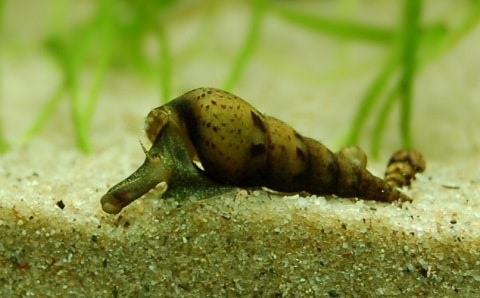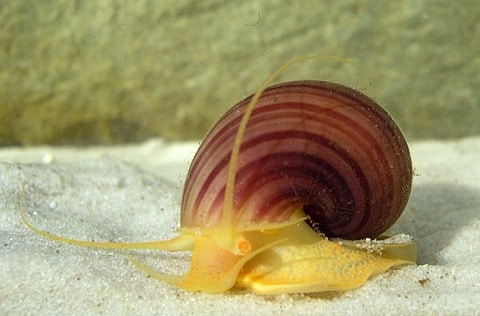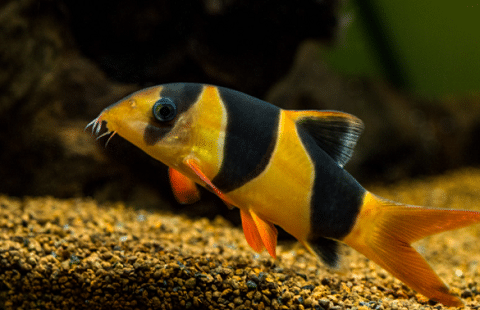Feeding Egg Shells to a Snail
Thank you for visiting! By the way… any links on this page that lead to products on Amazon and other stores/partners are affiliate links. Aquarium Store Depot earns a commission if you make a purchase.
Are you struggling to keep your aquarium clean because of snail eggs? If so, you're not alone. Snail eggs can be a real pain to deal with, but luckily there are ways to prevent them from taking over your tank. In this blog post, we'll discuss what causes snail eggs to form and how you can stop them from becoming a problem. We'll also provide some helpful tips for removing and cleaning up snail egg masses. So if you're ready to take back control of your aquarium, keep reading!
Freshwater Snails (Where Snail Eggs Come From)
Snail eggs start with adult snails. Whether you like it or not, snails will most likely end up in your freshwater fish tank. These invertebrates are some of the most successful hitchhikers, invading tanks by the hundreds.
The problem is that snails start off very small. They like to attach themselves to live plants and other aquarium decorations before being transferred to a new tank, making the transition from one setup to another seamless. Even more so, most freshwater snail eggs are extremely difficult to spot and are mostly immune to pesticides.
Once in the aquarium, snails will continue to reproduce either sexually or asexually; as we'll see, there is one species of aquarium snail in particular that needs brackish water conditions to reproduce and is the most optimal choice for controlled systems. Otherwise, snail overpopulation can become a big problem for hobbyists very quickly as more snails equal more waste.
To understand how snails reproduce, we need to first understand more about the different species available to hobbyists. The main species are:
- Malaysian trumpet snails (Melanoides tuberculata)
- Ramshorn snails (Planorbidae family)
- Mystery snails (Pomacea bridgesii)
- Assassin snails (Anentome helena)
- Nerite snails (Nerita spp.)
Malaysian Trumpet Snails

- Scientific name: Melanoides tuberculata
- Maximum size: 1 inch
- Minimum tank size: 10 gallons
- Reproduction: Asexually
- Pest: Yes
Malaysian trumpet snails are some of the most problematic snails as they are believed to reproduce asexually. These snails are small and difficult to see on incoming plants and decorations as they stay under an inch long.
These aquarium snails are so problematic because not only are they asexual, but they also give birth to live young. This makes it impossible to prevent reproduction; as long as there is food in the tank, this freshwater snail species will continue to reproduce indefinitely.
Ramshorn Snails

- Scientific name: Planorbidae family
- Maximum size: 1-2 inches
- Minimum tank size: 10 gallons
- Reproduction: Sexually
- Pest: Yes
Ramshorns are unique and beautiful snails, which is probably why they end up overrunning so many aquarium systems. They have tight, swirled shells that can come in many light and dark color variations. Ramshorn snails are also effective algae cleaners and don't take up a lot of space.
The problem is that many beginner hobbyists see these freshwater snails and think to add several to their new tank. As a sexual snail species, ramshorn snails will reproduce and lay eggs almost immediately. Once ramshorn snails have entered your aquarium, they will continue to thrive based on food availability.
Ramshorn snail eggs are some of the most difficult to see, with a transparent sac surrounding nearly transparent eggs. These eggs are usually laid at or below the waterline.
Mystery Snails

- Scientific name: Pomacea bridgesii
- Maximum size: 1-2 inches
- Minimum tank size: 10 gallons
- Reproduction: Sexually
- Pest: Yes
Mystery snails are one of the most common freshwater snails to come across in your local pet store, but you won't find them in more experienced hobbyist tanks. These snails might look like great cleaners, but they're simply too large and reproduce too quickly if more than one snail is in the aquarium.
This species is one of the most colorful, ranging in color from light greys and yellows to marbled browns. However, they're not the best at cleaning algae and can become a pest if allowed to reproduce. It's believed that their radula, or their teeth-like structure, are not as strong as better algae-eating snails. Because these snails are comparatively big, they do better in larger tanks.
Mystery snail eggs are some of the largest and most noticeable. These clutches are very dense and usually laid at or above the waterline on the aquarium glass.
Assassin Snails
- Scientific name: Anentome helena
- Maximum size: 3 inches
- Minimum tank size: 30 gallons
- Reproduction: Sexually
- Pest: No
Assassin snails are another popular aquarium snail species in the hobby due to their usefulness (video from The Dave). As their name implies, they are predatory snails that will attack and eat other snails. This can be very useful for controlling pest snail populations. Unfortunately, this also means that they'll leave problematic algae alone.
Assassin snails are one of the bigger species of snail and need a larger minimum tank size. They have a bright brown and yellow swirled shell that provides color to the aquarium while serving a purpose. This helps them blend into the substrate, where they will burrow and bury themselves until ready to feed.
As for freshwater snails, assassin snails are the least likely to overpopulate an aquarium as they need a sexual partner and lay eggs one at a time. Though they'll kill most snail species and even possibly dwarf shrimp, they'll mostly leave larger ones alone.
Assassin snail eggs are singular and hard to see. They are most often laid on the aquarium glass in translucent sacs.
Nerite Snails
Best Algae Snail

- Scientific name: Neritina spp.
- Maximum size: 1 inch
- Minimum tank size: 10 gallons
- Reproduction: Sexually
- Pest: No
Nerite snail species are probably the best snail to have in both the freshwater and saltwater aquarium. These snails are great cleaners, stay relatively small, and have attractive yellow and brown swirled shells.
The best thing about Neritina species is that they need brackish or saltwater conditions to reproduce. This makes it impossible for nerite snails to overpopulate a freshwater tank, leaving them to focus on cleaning.
Still, it is very common for females nerite snails to lay eggs in the freshwater aquarium. These nerite snail eggs will look like small white capsules on the underside of driftwood, rocks, and plants. However, they will not hatch if the water never becomes saline.
Snail Eggs
If you introduce any of the freshwater snails on this list into your aquarium, you're bound to find snail eggs. Whether these eggs are fertilized and hatch will depend on the species of aquarium snail you're dealing with. It is safe to say that ramshorn snail and mystery snail eggs will all be fertilized and turn into a bunch of baby snails.
First, you need to be able to identify what aquarium snail eggs look like. Then, you can deal with removing them and controlling snail populations.
What Do Freshwater Aquarium Snail Eggs Look Like?

Freshwater snails eggs are easy to identify but difficult to find.
Snails lay their eggs in safe areas that are hard to reach or out of sight. This means under the leaves of live plants, driftwood, and even rocks, though sometimes snails will lay eggs right at the waterline. Looking for snail eggs is especially important when bringing new live plants into the aquarium as they can be easy to miss, causing a snail infestation.
For the most part, freshwater snail eggs look the same no matter the species of snail. Snail eggs are laid in a clutch. Each egg clutch is filled with individual eggs safely packed within a transparent gelatinous sac. This is in contrast with nerite snails that lay individual eggs in a line.
These individual infertile eggs can be blue, pink, or creamy and are slightly transparent. Once they become fertilized eggs, they will turn darker in color and have observable dark and brown spots across the individual egg. If the eggs go unfertilized, they will not change in color or appearance.
How Long Do Snail Eggs Take To Hatch?
Again, how long it takes for snails eggs to hatch will depend on the species. In general, freshwater snail eggs will hatch in between 2 to 4 weeks after being fertilized.
Water parameters, especially water temperature, will greatly influence how quickly eggs hatch. However, there aren't many benefits to speeding up the process as snails are easy to breed.
If several weeks pass and your baby snails have yet to hatch, then there is a chance that something went wrong or they were never fertilized. At this point, the unfertilized eggs may be removed or left in the tank for other fish and invertebrates to eat.
Removing Snail Eggs
As mentioned before, many hobbyists struggle with snail infestations. Having too many snails is not always a good thing as there start to be more disadvantages than benefits.
But how do you know if you should remove snail eggs from your aquarium or not?
Unless you're breeding snails for a reason, like for feeding predatory fish, snail eggs should always be removed from the aquarium. After the first pair of snails, the population growth becomes exponential, which can quickly get out of hand.
Snails help will algae up until a point. After that, they create large amounts of waste that take away from other livestock and can even damage plants if they weigh too much. The problem is that snail eggs are hard to find and you're left with catching and destroying hundreds of baby snails, which definitely doesn't feel great to do. This is why we recommend removing the eggs before they get to that point.
Here are the best ways to remove freshwater snail eggs before they get the chance to hatch.
Manual Removal
The best way to remove snail eggs from your aquarium is by manual removal. This is very easy to do especially if the eggs are on the side of the aquarium glass.
Simply use a thin card or razor blade to separate the clutch from the glass. Then you may squish them or submerge them in vinegar.
If the snail eggs are stuck onto the side of driftwood or a rock, then you may need to remove the affected piece. Both the driftwood and rock may be scrubbed or scraped of the eggs. The driftwood can also be boiled if need be.
Biological Solutions

Luckily, snail eggs are high in protein and are the preferred diet for many freshwater fish and invertebrates. Unfortunately, many of these egg-hungry species also enjoy eating adult and baby snails, which may cause some problems. As long as the snail is larger than the fish, there should be no problems for adult snails.
Some of these fish include:
- Loaches – yoyo loach (Botia almorhae), clown loach (Chromobotia macracanthus), kuhli loach (Pangio kuhlii)
- Corydoras – emerald green cory (Corydoras splendens), bronze cory (Corydoras aeneus), panda cory (Corydoras panda)
- Betta fish (Betta splendens)
- Gouramis – dwarf gourami (Trichogaster lalius), honey gourami (Trichogaster chuna), three spot gourami (Trichopodus trichopterus)
There are a few problems with getting rid of aquarium snail eggs through biological solutions, however. The main problem is that more fish require more room.
Most types of loach and Corydoras need to be kept in schools of six or more individuals. This is a large long-term addition to the aquarium for a temporary problem. If space is available and the setup is right, then these fish will happily live even when the natural supply of snail eggs has run out.
The other problem with using a biological solution to treating snail eggs is that not all snails lay their eggs in the same areas of the tank. Loaches and Corydoras live on the bottom of the tank but your snail may choose to lay its eggs towards the top of the tank or out of the water completely.
Though these fish will surely take care of any eggs or baby snails near the bottom of the tank, it is up to the hobbyist to remove the eggs that are out of reach.
Remember that the assassin snail is also a good predatory species to control a large snail population.
Prevention
Of course, the best way to get snail eggs out of your aquarium is by never introducing them in the first place! This is easier said than done, though it is possible.
When picking out your clean-up crew, choose snails that use their time to eat algae and not to lay eggs. One of the best options of freshwater snail is the nerite snail as it checks both these boxes.
Observe and treat new live plants for aquarium snail eggs and baby snails. Some hobbyists choose to quarantine their plants just as they would for new fish or invertebrates. This can be a lengthy process but is definitely the most effective way at preventing unwanted pests from entering the aquarium.
Otherwise, thoroughly go over the stems and leaves of the plants for transparent egg clutches. There are several dip options that can also be effective:
- A dip of 2-3 mL 3% hydrogen peroxide to 1 gallon of water
- A dip of 1:19 ratio of bleach to water
- A dip of potassium permanganate that has reached a dark pink or purple color when mixed with water
These dips can be effective for removing not only unwanted snails, but also various types of bacteria, fungus, and parasites.
If you do not use any methods to prevent snails from coming into your aquarium, they will find their way in time.
Another great way to prevent snails is to best pest free plants. These plants are going to be tissue cultures and will be sold by specially retailers. Not all types of plants are available as tissue cultured though.
Final Thoughts
Snails are a necessary part of the freshwater aquarium ecosystem, but snail eggs are not. Many species of freshwater snail reproduce too quickly in the home aquarium, leaving tanks to be overrun. Luckily, there are a few types of snail that have slow reproduction rates or that can't successfully reproduce in freshwater entirely.
If freshwater snail eggs do happen to enter the aquarium, then some consistent manual removal or biological intervention may help solve the problem.
Source: https://aquariumstoredepot.com/blogs/news/snail-eggs
0 Response to "Feeding Egg Shells to a Snail"
Post a Comment